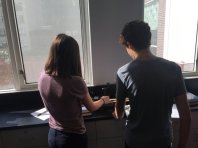Today was the start of some important changes in how I am viewing and structuring my intro physics class (Physics 10). We are just into our second day of the Balanced Forces Particle Model. On the first day, we built Olivia’s (First) Law — that unbalanced interactions mean changing velocity and balanced interactions mean constant velocity (more on this later, maybe, if I get around to backdating a post for Friday).
Today, we spent the first part of class working in groups and making rounds through six stations to observe interactions. Here is the page from the packet:

And here are photos of students and the stations (not in order of the page because I’m not going to have patience to work that out—sorry!):
Some of the stations are just a little different from the descriptions because I didn’t always have exactly what I thought I would have. And no, we don’t use those books for anything but just what you see here (ramps, supports, etc).
You will see that I basically straight up stole these ideas from Brian Frank. (Thank you, Brian!)
Before they started, we had already defined focused our idea about force as an interaction between two objects. (Tapping -> interaction -> force—thank you Frank! And shout out to 2011 and Twitter!)
To give context to this activity, I told them there were three pieces of evidence they could look for to notice a contact interaction: compression, stretch, and shearing. We made sure everyone knew what all three meant (almost everyone knew the first two, almost no one knew the third, but they got it from a quick sketch and recognized it when they saw it later). So at each station, they had to identify one interaction (there were usually multiple obvious ones and they could choose any) and think through which objects were interacting and what evidence they had for that contact interaction.
After they finished the stations, I spent way less than half the time I have spent in the past on the process of giving some vocabulary to the forces (tension force, normal force, friction force, gravitational force) and in that amount of time, we also put together our first three system schemas and FBDs using examples from our first two days of the unit, not the ones on that old blog post.
The coolest thing was how big of an effect the shift to the interaction stations seemed to have already. (Of course, time will tell more.) As we worked through the three situations, students kept using the language of compression, stretch, and shearing. I really wondered about delaying the Fn/Ft/Ff language once I saw that they felt so comfortable with what they had observed themselves (duh!), but it was already too late. It’s great to have these interchangeable terms.
Can’t wait for tomorrow when we start thinking about pushing a box on a concrete floor! (Anyone who has been through my class knows this actually is pretty exciting even though it sounds boring!)









4 thoughts on “Day 10: Interaction Stations”